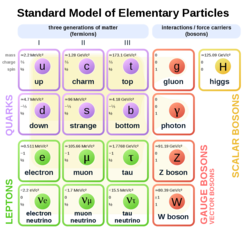New symmetries could be the reason why there are only the known constituents of matter
Exploiting a coincidence with N=8 supergravity, a new study uses novel symmetries to explain why there are only the observed quarks and leptons
Results from LHC so far have shown no hints of “new physics” beyond the well established Standard Model of Particle Physics – in obvious conflict with numerous proposed extensions postulating a large number of new particles. Exploiting a remarkable coincidence with N=8 supergravity first observed by M. Gell-Mann, the new publication by AEI director Hermann Nicolai with his Polish colleague K. A. Meissner proposes a radically different approach: novel infinite-dimensional duality symmetries can account for the observed spectrum of quarks and leptons including right-chiral neutrinos, together with its replication in three and only three generations.
Paper abstract

Following up on our earlier work where we showed how to amend a scheme originally proposed by M. Gell-Mann to identify the 48 spin 1/2 fermions of N=8 supergravity that remain after complete breaking of N=8 supersymmetry with the 3x16 quarks and leptons of the Standard Model, we further generalize the construction to account for the full SU(3)_c x SU(2)_w x U(1)_Y assignments, with an additional family symmetry SU(3)_f. Our proposal relies in an essential way on embedding the SU(8) R-symmetry of N=8 supergravity into the (infinite-dimensional) “maximal compact” subgroup K(E10) of the conjectured maximal duality symmetry E10. As a by-product, it predicts fractionally charged and possibly strongly interacting massive gravitinos. It also indicates how E10 and K(E10) can supersede supersymmetry as a guiding principle for unification












